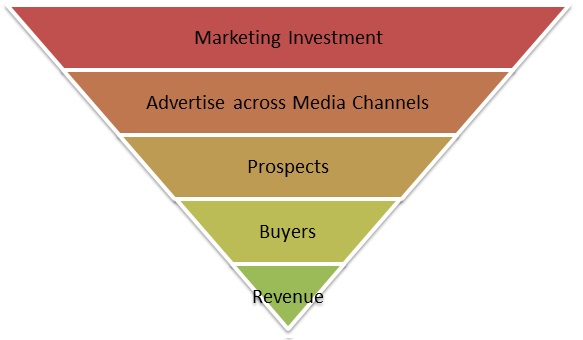- Business Concepts ›
- Marketing and Strategy ›
- Return on Marketing Investment (ROMI)
Return on Marketing Investment (ROMI)
Definition, Importance & Example
This article covers meaning & overview of Return on Marketing Investment (ROMI) from marketing perspective.
What is meant by Return on Marketing Investment (ROMI)?
Return on marketing investment (ROMI) is a metric that is used to measure the effectiveness of a marketing campaign or a combination of marketing campaigns done for a product or service. Return on marketing investment or ROMI is evaluated in terms of extra profits generated against the costs incurred due to marketing efforts. ROMI or marketing return on investment (MROI) is a subset of Return on Investment (ROI) as ROI is a broader term and is used to measure the overall gain or loss incurred with respect to the investment made by a company whereas ROMI is the profit made or loss incurred with respect to investment made in the marketing campaigns only.
Marketing of a product or service can be done though one or more of the various mediums like print media, social media, websites, TV Advertisements, hoardings, magazines etc. Marketers resolve to MROI to measure the effectiveness of these marketing channels.
Importance of Return on Marketing Investment (ROMI)
Marketing of a product or a service can be done through various different channels. There are costs associated with marketing through these channels which are all different with respect to different marketing channels. Similarly, the revenue or the return generated through these different channels is all different. Some channels may give a higher profit, some a little profit, some may generate loss.
Here, Return on marketing investment comes into picture.
With the help of ROMI, marketers clearly get to know if all the time and money invested in the marketing campaign is even worth or not. They get to know, which channel is generating the maximum profit for them and because of which channel they are incurring losses. This, in turn, helps them to improvise on the findings and plan their future course of actions. For example, based on MROI findings, if newsletters or free trials are giving them a very good ROMI, marketers may plan to promote the newsletter subscriptions and increased number of free trials for their product.

Formula of Return on Marketing Investment (ROMI)
Return on marketing investment (ROMI) = (Gross Profit – Marketing Investment)/ (Marketing Investment)* 100
Where, Gross Profit= Revenue Generated – Cost of Goods Sold
Marketing Investment= Investment made in Marketing Channels
Advantages and Disadvantages of ROMI
Some advantages of MROI (marketing return on investment) are:
1. It helps companies help understand their performance and marketing effectiveness.
2. ROMI helps to understand which channels their customer preference.
3. In the future, MROI can help avoid unnecessary costs.
Some disadvantages of marketing return on investment (MROI) are:
1. Return on marketing investment takes into account only the extra revenue generated because of a marketing campaign of a product or service but does not takes into account other less tangible benefits. For example, a marketing campaign may not have generated an extra revenue for a product, but because of the marketing campaign, the attitude of people and the brand image towards this brand may have substantially improved, its visibility may have increased and now people know more about it and associate with it which ROMI fails to take into account.
2. Many times, multiple marketing campaigns are in function for a product rather than just 1. It may happen that a particular marketing channel may not be generating so much of extra revenue for the company but the presence of the marketing campaign on this channel may be having a positive effect on other channels for the same advertisement in terms of the extra revenue generated. ROMI fails to take this factor into consideration.
Example of Marketing Return of Investment (MROI)
Suppose a company X sells mobile phone online on an e-commerce website “Flipkart” and “Amazon”. Currently the company is able to generate monthly revenue of Rs.5,00,000 with profit being 20% i.e. Rs.1,00,000. Now, the company decides to launch the Advertisements in TV, social media and magazines which collectively cost the company Rs. 30,000.
Due to this additional marketing, now the sales improve and the new monthly revenue is Rs. 7,00,000 with same profit percentage i.e. 20% which gives Rs.1,40,000 as profit.
Now, MROI is calculated as = (Gross Profit – Marketing Costs)/ (Marketing Costs)* 100 = (1, 40,000- 1, 00,000- 30000)/ (30000)* 100 = 33.33%
Hence, this concludes the definition of Return on Marketing Investment (ROMI) along with its overview.
This article has been researched & authored by the Business Concepts Team which comprises of MBA students, management professionals, and industry experts. It has been reviewed & published by the MBA Skool Team. The content on MBA Skool has been created for educational & academic purpose only.
Browse the definition and meaning of more similar terms. The Management Dictionary covers over 1800 business concepts from 5 categories.
Continue Reading:
What is MBA Skool?About Us
MBA Skool is a Knowledge Resource for Management Students, Aspirants & Professionals.
Business Courses
Quizzes & Skills
Quizzes test your expertise in business and Skill tests evaluate your management traits
Related Content
All Business Sections
Write for Us